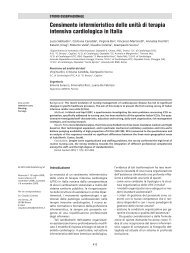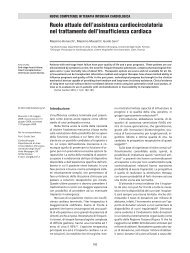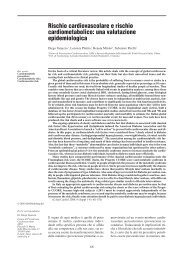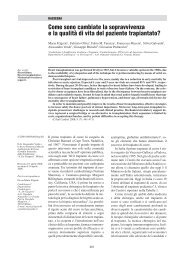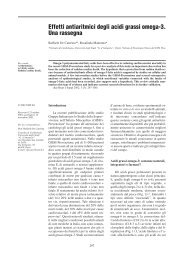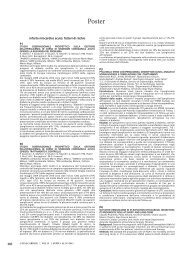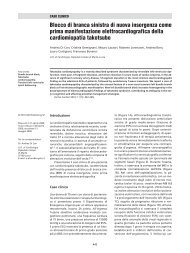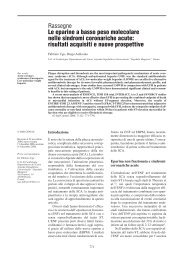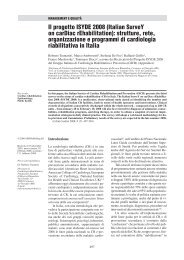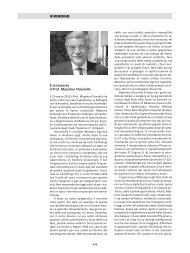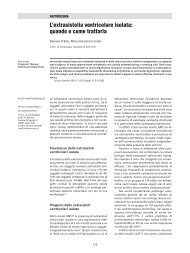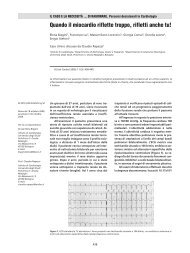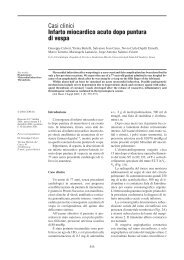COMUNICAZIONI - Giornale Italiano di Cardiologia
COMUNICAZIONI - Giornale Italiano di Cardiologia
COMUNICAZIONI - Giornale Italiano di Cardiologia
You also want an ePaper? Increase the reach of your titles
YUMPU automatically turns print PDFs into web optimized ePapers that Google loves.
G Ital Car<strong>di</strong>ol Vol 8 Suppl 2-5 2007<br />
car<strong>di</strong>ovascular morbi<strong>di</strong>ty and mortality in <strong>di</strong>abetic patients. Strain (S) and strain<br />
rate (SR) echocar<strong>di</strong>ography are emerging ultrasound techniques that improve the<br />
accuracy and reproducibility of conventional echocar<strong>di</strong>ography stu<strong>di</strong>es.<br />
Aim of this study. To test the ability of atrial strain to identify <strong>di</strong>astolic dysfunction<br />
grade and heart failure functional signs.<br />
Materials and methods. We stu<strong>di</strong>ed 100 subjects, whose 50 (28M, 22F, mean<br />
age: 62 years) with CAD assessed by coronary angiography with <strong>di</strong>abetes<br />
mellitus and without valvular <strong>di</strong>sease, hypertension, <strong>di</strong>lated or hypertrophic<br />
car<strong>di</strong>omyopathy or congenital heart <strong>di</strong>sease and 50 (30M, 20F) controls.<br />
Echocar<strong>di</strong>ography System Seven GE with TVI function on each patients. A M-<br />
mode, bi<strong>di</strong>mensional, Color Doppler, Pulsed and Continuous Doppler<br />
(transmitral, transtricuspid and pulmonary vein flow) and TVI echocar<strong>di</strong>ographic<br />
study was performed. Left (LA) and right atrial (RA) <strong>di</strong>ameters, left and right<br />
atrium EF(%) and propagation velocity of early <strong>di</strong>astolic flow (Pv), at Colour M-<br />
mode Doppler of transmitral inflow, were measured. Pulmonary artery wedge<br />
pressure was calculated by E/Ea. Peak systolic tissue atrial S and SR were<br />
evaluated in 4 and 2 chamber views at the level of the septal, lateral, anterior and<br />
inferior atrial walls near the roof, and at the level of the right atrial free wall near<br />
the roof.<br />
Results. A significant <strong>di</strong>rect correlation was found between pulmonary artery<br />
wedge pressure and left and right atrial <strong>di</strong>ameters (P=0,005; R=0,63), left and<br />
right atrial volumes (P=0,004; R=0,73), early <strong>di</strong>astolic velocity (E wave) and late<br />
<strong>di</strong>astolic velocity (A wave) (P=0,003; R=0,64). A <strong>di</strong>rect correlation was found<br />
between <strong>di</strong>astolic reverse flow duration (Ar dur) and left atrial end-<strong>di</strong>astolic and<br />
end-systolic volumes (P=0,001; R=0,74). The myocar<strong>di</strong>al atrial S and SR were<br />
found to be significantly (p=0,003) lower for each wall (both left and right atrium)<br />
in patients with <strong>di</strong>abetes than in controls. A significant inverse correlation was<br />
found between left and right atrial S and SR (P=0,03; R=-0,71) and pulmonary<br />
artery wedge pressure and left and right atrial EF. An inverse correlation was<br />
found between pulmonary artery wedge pressure and propagation velocity of<br />
early <strong>di</strong>astolic flow (Pv) (P=0,003; R=-0,63) and a <strong>di</strong>rect correlation between<br />
pulmonary artery wedge pressure and mitral forward A wave (A) (P=0,004;<br />
R=0,72).<br />
Conclusions. Atrial strain (S) and strain rate (SR) and <strong>di</strong>fferent TVI parameters<br />
identify elevated pulmonary artery wedge pressure and <strong>di</strong>astolic dysfunction<br />
grade in <strong>di</strong>abetic patients with CAD and authorize aggressive therapeutic<br />
intervention in such patients.<br />
C44<br />
PATIENTS AFFECTED BY HEART FAILURE WITH PEAK OXYGEN<br />
CONSUMPTION BETWEEN 10-18 ML/KG/MIN: CAN CARDIOPULMONARY<br />
TEST PROVIDE ADDITIONAL PARAMETERS FOR A BETTER PROGNOSTIC<br />
STRATIFICATION?<br />
M. Merlo, D. Clama, E. Berton, A. Magagnin, A. Pivetta, S. Pyxaras, G. Secoli,<br />
M. Moretti, A. Di Lenarda, G. Sinagra<br />
Car<strong>di</strong>ovascular Department, “Ospedali Riuniti” and University of Trieste, Trieste,<br />
Italy<br />
Background. Peak oxygen consumption (VO2) an old-time classic parameter<br />
used to stratify HF patients (pts) was recently combined to VE/VCO2 slope, in<br />
order to improve heart transplant selection criteria. The lack of prognostic factors<br />
is particularly evident in the subgroup of pts with interme<strong>di</strong>ate grade of risk (i.e.<br />
with a peak VO2 between 10 and 18 ml/kg/min). We sought to analyse the<br />
pre<strong>di</strong>ctive role of aerobic indexes obtained during Car<strong>di</strong>opulmonary Exercise<br />
Testing (CPET) in pts affected by i<strong>di</strong>opathic <strong>di</strong>lated car<strong>di</strong>omyopathy (IDC) with a<br />
peak VO2 between 10 and 18 ml/kg/min.<br />
Methods. We analyzed 171 IDC pts enrolled in the Trieste Heart Muscle Disease<br />
Registry who underwent CPET from 1997 and 2005. Among these, 97 pts had<br />
a peak VO2 between 10 and 18 ml/kg/min (mean age 48±10 yrs, males 71%,<br />
NYHA class III-IV 20%, left ventricle ejection fraction (LVEF) 0.30±0.11, peak<br />
VO2 14±2 ml/kg/min, ACE-inhibitors 93%, beta-blockers 88%). Combined endpoint<br />
was considered Car<strong>di</strong>ovascular Death/Major Ventricular Arrhythmias/<br />
Car<strong>di</strong>ovascular Hospitalizations at 1 year.<br />
Results. At univariate analysis, pts who satisfied the end point criteria at oneyear,<br />
in comparison with those who <strong>di</strong>d not, showed a trend towards more<br />
advanced functional NYHA class, lower LVEF and lower circulatory power. The<br />
only parameter significantly associated to our combined end-point resulted a<br />
higher VE/VCO2 slope (34±7 vs 29±4, p=0.003). At multivariate analysis<br />
VE/VCO2 slope was selected as an independent pre<strong>di</strong>ctor of one-year<br />
car<strong>di</strong>ovascular endpoint (for a 2-unit increase: O.R.1.41, 95% I.C. 1.08-1.85,<br />
p=0.012) together with LVEF (for a 5-point decrease: O.R.1.71, 95% I.C. 1.08-<br />
2.71, p=0.025). At ROC curves VE/VCO2 slope had an AUC of 0.694 for our study<br />
end-point with a cut-off value of 28 (Figure 1).<br />
Conclusions. In pts classified at interme<strong>di</strong>ate risk accor<strong>di</strong>ng to peak VO2,<br />
VE/VCO2 slope may add prognostic power to identify pts at higher risk of early<br />
heart transplant in<strong>di</strong>cation.<br />
Prognosi dello scompenso car<strong>di</strong>aco<br />
C43<br />
RUOLO PROGNOSTICO ADDITIVO DEL TEST CARDIOPOLMONARE NELLA<br />
STRATIFICAZIONE DEL RISCHIO DEL PAZIENTE ANZIANO CON<br />
SCOMPENSO CARDIACO CRONICO<br />
A.B. Scardovi, R. De Maria, C. Coletta, S. Perna, N.A. Aspromonte, M. Feola,<br />
G.L. Rosso, P. D’Errigo, A. Pimpinella, A. Carunchio, B. Krakowska,<br />
T. Di Giacomo, R. Ricci, V. Ceci<br />
Ospedale S. Spirito, Roma, Ospedale S. Andrea, Roma<br />
Premessa. La stratificazione del rischio nei pazienti (pz) anziani affetti da<br />
scompenso car<strong>di</strong>aco (SC) è particolarmente complessa. Infatti, nonostante i<br />
recenti progressi nel trattamento dello SC, l’incidenza <strong>di</strong> mortalità e morbilità<br />
rimangono alte in questo tipo <strong>di</strong> popolazione. Il test car<strong>di</strong>opolmonare (CPX) è uno<br />
degli strumenti principali per stratificare la prognosi, ma i parametri normalmente<br />
utilizzati sono derivati dall’osservazione <strong>di</strong> pz relativamente giovani e <strong>di</strong> sesso<br />
maschile. Allo stato attuale non si hanno informazioni esaurienti circa il ruolo<br />
prognostico del CPX, in aggiunta ai parametri clinici, ecocar<strong>di</strong>ografici e <strong>di</strong><br />
laboratorio sui quali normalmente viene formulata la valutazione prognostica, in<br />
pz anziani con SC. L’obiettivo del nostro lavoro è stato <strong>di</strong> verificare se il CPX fosse<br />
in grado <strong>di</strong> affinare il giu<strong>di</strong>zio prognostico in una popolazione <strong>di</strong> pz anziani con SC<br />
lieve-moderato, già valutata con i parametri tra<strong>di</strong>zionali.<br />
Meto<strong>di</strong> e Risultati. 223 pz anziani, consecutivi, stabili, affetti da SC con terapia<br />
ottimizzata, sono stati valutati in regime ambulatoriale sottoponendoli ad esami<br />
ematici <strong>di</strong> routine, dosaggio del BNP plasmatico, ecocar<strong>di</strong>ogramma Doppler e<br />
CPX massimale. La me<strong>di</strong>ana dell’età era 75 (68, 90) anni, il 32% erano donne, la<br />
classe funzionale NYHA era I-III. La frazione <strong>di</strong> eiezione me<strong>di</strong>a ecocar<strong>di</strong>ografica<br />
del ventricolo sinistro era 40±13%. Un quoziente respiratorio al picco<br />
dell’esercizio (RER) ≥1.05 veniva considerato come un in<strong>di</strong>ce <strong>di</strong> massimalità<br />
dell’esercizio svolto. La me<strong>di</strong>ana del BNP era 140 [10, 1322] pg/ml; un pattern <strong>di</strong><br />
riempimento del ventricolo sinistro <strong>di</strong> tipo restrittivo era presente in 40 pazienti<br />
(18%). Al CPX l’80% dei pz aveva raggiunto un RER ≥1.05, la me<strong>di</strong>ana del<br />
consumo <strong>di</strong> ossigeno al picco dell’esercizio era 12 [4.8, 20.7] ml/kg/min ed una<br />
risposta iperventilatoria all’esercizio [EVR, espressa come la pendenza della<br />
retta <strong>di</strong> regressione che correla la ventilazione con la produzione <strong>di</strong> CO 2<br />
(VE/VCO2 slope) >33] veniva rilevata in 77 pz (35%) Durante un periodo <strong>di</strong><br />
osservazione <strong>di</strong> 684 giorni (range 38-1928) 87 pz morirono o furono ricoverati per<br />
instabilizzazione delle con<strong>di</strong>zioni <strong>di</strong> compenso (39%). In aggiunta alle semplici<br />
variabili cliniche e <strong>di</strong> laboratorio (età, sesso, clearance della creatinina, blocco <strong>di</strong><br />
branca sinistro, BNP), una EVR, identificata da un elevato VE/VCO2 slope,<br />
considerato con una soglia <strong>di</strong> 33, aveva un valore prognostico ad<strong>di</strong>tivo (HR 1.57<br />
[0.94 a 2.60]) aumentando il rischio <strong>di</strong> eventi avversi del 57%.<br />
Conclusioni. Nei pz anziani con SC il CPX è in grado <strong>di</strong> fornire informazioni<br />
prognostiche ad<strong>di</strong>tive alle normali indagini strumentali e <strong>di</strong> laboratorio utilizzate<br />
per valutare il rischio <strong>di</strong> eventi avversi. In particolare il rilievo <strong>di</strong> EVR, definita come<br />
VE/VCO2 slope >33, inferiore a quello comunemente utilizzato, è in grado<br />
d’identificare un sottogruppo <strong>di</strong> pz ad alto rischio all’interno <strong>di</strong> una popolazione <strong>di</strong><br />
soggetti con SC lieve-moderato. Queste osservazioni estendono alla popolazione<br />
anziana le consapevolezze relative ai pz più giovani e raccomandano l’utilizzo del<br />
CPX <strong>di</strong> routine per la stratificazione prognostica dell’anziano con scompenso<br />
car<strong>di</strong>aco.<br />
C45<br />
PROGNOSTIC ROLE OF HEMODYNAMIC EVALUATION AT REST AND<br />
DURING EXERCISE IN PATIENTS WITH IDIOPATHIC DILATED<br />
CARDIOMYOPATHY<br />
S. Pyxaras 1 , M. Merlo 1 , A. Pivetta 1 , D. Chicco 1 , A. Aleksova 1 , E. Daleffe 1 ,<br />
B. D’agata 1 , A. Di Lenarda 1 , G. Sinagra 1<br />
1<br />
Car<strong>di</strong>ovascular Department “Ospedali Riuniti” and University of Trieste, Trieste,<br />
Italy<br />
Background. I<strong>di</strong>opathic Dilated Car<strong>di</strong>omyopathy (IDC) is a major in<strong>di</strong>cation for<br />
heart transplant (HT). Since the results of ergospirometry testing are influenced<br />
by treatment and non car<strong>di</strong>ac features, we sought to identify ad<strong>di</strong>tional tools to<br />
select patients (pts) to HT.<br />
Aim. To determine the role of hemodynamic evaluation at rest and during<br />
exercise in prognostic stratification of pts with IDC.<br />
Methods. Invasive hemodynamics at rest and during maximal bicycle exercise<br />
were evaluated in 61 pts (age NYHA LVEF, ACE BB) enrolled from 1987 to 1993<br />
in the Heart Muscle Disease Registry of Trieste. An abnormal hemodynamic<br />
pattern at rest was defined as the presence of right atrial pressure ≥6 mmHg<br />
and/or mean pulmonary arterial pressure ≥20 mmHg and/or pulmonary capillary<br />
wedge pressure (PCWP) ≥15 mmHg and/or car<strong>di</strong>ac index



